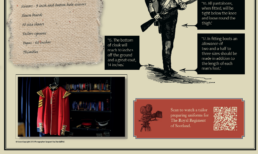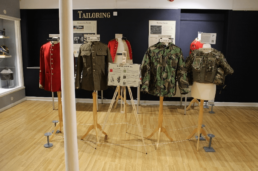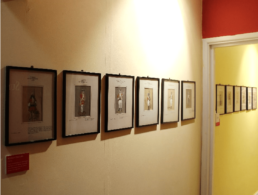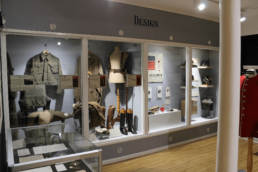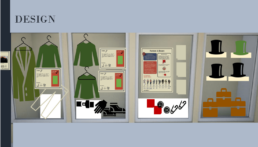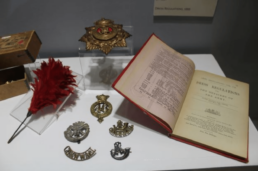SUITED & BOOTED
CURATED BY FRAN SINGLETON AT BODMIN KEEP
The exhibition, ‘Suited and Booted’ tells a history of the design and wear of military uniform. It builds on the common narrative in military uniform exhibitions, looking at the reasons for changes in uniform by instead exploring the design, making, tailoring and upkeep of uniform.
What has remained constant throughout military history is the Suiting and Booting of a soldier from the Quartermasters clothing store where uniform is issued. Military uniform has been formally worn since the end of the English Civil War (1649) where the use of armbands as a symbol of loyalty was not enough to distinguish armies.
Until 1855 it was the Regimental Colonel’s responsibility to supply the uniform. After this the Army Clothing Department dealt with suppliers directly and shortly after began manufacturing uniforms in a purpose-built factory in Pimlico, London. Since its closure in 1932, the Defence Equipment & Support Agency has taken over the supply of uniform.
CURATORIAL TASK: REFLECTIVE WRITING
Suited & Booted Exhibition at Bodmin Keep: Making the History of Military Uniform More Accessible
Thematic Development
I am the Trainee Curator at Bodmin Keep for 2022. Bodmin Keep is a military museum situated in the historic headquarters of the Duke of Cornwall’s Light Infantry and holds collections relating to it and more recent collections from The Light Infantry. As part of the Trainee Curator internship, each Trainee must produce a final project at their respective museum, and I was given the brief of curating a textile exhibition with the existing museum collections in mind. When I first came across a book of clothing patterns drafted by a military tailor, I discovered the potential to explore the process of making uniform and all the underlying decisions that go into its construction. From this I expanded the exhibition scope which resulted in three themes from which to structure the exhibition: Design, Tailoring, and Care & Repair.
I wanted to make the topic of military uniform relatable to a variety of audiences by breaking down the elements of uniform design and displaying it as lifecycle from conception to repair. I introduce the exhibition with what uniform is, why the Army decided to officialise what soldiers wore after the English Civil War (1642-1649) and how it has developed into what is worn today. Topics such as the use of insignia in uniform (badges, buttons, and patches bearing regimental emblems) are often overly specialist and often displayed out of context from the uniform it is designed to be worn on. I was keen to take on the challenge to make this topic more accessible to the everyday visitor.
Touch and display
For the Fabric & Pattern display within the first theme, Design, I was inspired by a display of uniform in the Imperial War Museum London’s Holocaust Gallery and chose to hang garments on coat hangers, drape them over chairs and place boots as if they had just been taken off. This display highlights the use of natural materials for military uniform and their properties. I used infographics on the panels to distinguish their properties rather than overload the panels with text. I also attached swatches of fabric to allow people to touch the material and imagine how it may feel to wear it. The swatches were sourced from military tailors and online fabric shops to match the weave, texture, and colour of the original garments. This tactile element was particularly key as many ex-service people I spoke to in developing this project have memories of the particularly itchy wool. This often came in the form of an anecdote about shaving the inside of their Khaki flannel shirt to make it softer.
Visitor route
When considering the visitor route around the exhibition space, I had the challenge of curating in a room with two possible entrances. For the corridor entrance pictured I chose to maintain an existing vibrant red on the walls which catches the visitor’s eye as they head up the stairs to the second floor, With a vinyl sign pointing to the exhibition and watercolours on the opposite wall, leading the visitor to the entrance. This inclusion of watercolours also acted as a method of contextualising the exhibition content. From a collection of over 150 works depicting soldiers in uniform from the regiments represented in the museum, I selected 15 watercolours, all of soldiers of the same rank ranging from 1703 to 1914 to provide a visual timeline of uniform development. As you enter the exhibition room from either entrance, the line of four mannequins in uniform stands in the centre of the space as the most prominent feature. This simplifies the design progression shown in the watercolours by providing a visual reference for the four major changes in military uniform; the scarlet tunic, khaki jacket, Disruptive Pattern Material – the first universally issued camouflage, and the current Multi-Terrain Pattern camouflage in used since 2010. As someone with a fascination with social history but less knowledgeable about military history, I found this form of visual contextualisation extremely useful when I first started at Bodmin Keep.
Interactives
In the ‘Tailoring’ section I utilised other methods to engage the visitor which avoided tactile interaction as the nineteenth-century garments are on open display here. Using active terminology such as ‘Look at the intricate details’ and asking questions such as ‘can you spot the alterations on this tunic?’ gives agency to the user, suggesting ways of engaging that do not involve reading or touching.
I created QR codes linking to YouTube videos. This allowed an extra layer of interpretation which accessed footage and information relevant to the British Army today. I thought it important to include soldiers’ own experiences of uniform so for the section ‘Care & Repair’ I consulted ex-service people, including a member of staff who was in the Territorial Army who also brought a much-appreciated female perspective to uniform. Through a QR code, I was able to link a video about the recent developments in body armour to better protect a range of body types, as a result of a 2021 report emphasising the inequalities in the Army.
That relationship between the wearer and the garments is particularly relevant in an age where we are becoming more aware of our individual impact on the climate and how caring for and mending clothes can help reduce waste. Along with QR Code interactives, I repurposed material from previous 3D scanning project with Purpose 3D, including an iPad for people to zoom into the details. In the corner, dressing up and colouring was included for engagement. I used paper cut-outs of people and encouraged visitors to design their own uniform which has created a colourful display within the gallery.
© All rights reserved by Bodmin Keep.
